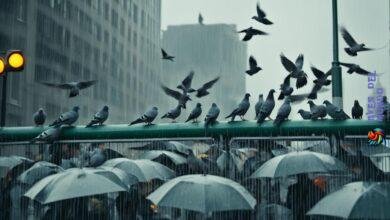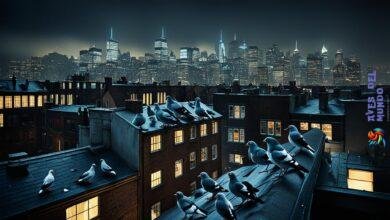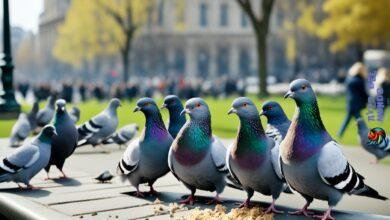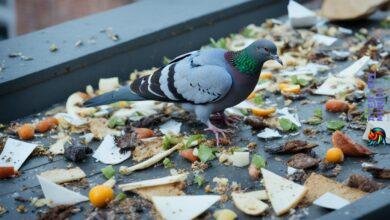In many city spaces, pigeons outdo native birds, often doubling their numbers. This extreme difference affects the ecosystems deeply, especially through the pushing out of native birds and the disturbances pigeons cause. These outside birds kick off a series of impacts, making life tough for the original bird species of cities.
As pigeons take over, they clearly impact urban birds. They are so good at adapting that they fight with local birds for food and places to live. This upsets nature’s balance, which used to support a variety of birds. Now, local birds find it hard to keep their place in cities that keep changing.
It’s important to know about this issue. Understanding pigeons’ effects is key to discussing urban nature and saving our bird friends.
Introduction to Pigeons as Urban Ecosystem Influencers
Pigeons light up urban landscapes with their presence. They are often seen as pests or pets. But, they play a big role in city ecologies. Their pigeon invasion effects show us how pigeons and native birds live together. The feral pigeon brings a new angle to urban wildlife talks. It highlights its effect on urban species ecology.
In city streets, you can hear pigeons cooing. These birds have become part of city life. They shape the biodiversity of urban areas. Their behavior helps us understand urban species ecology. It shows how they impact their habitat.
We need to see pigeons in a new light in our cities. They show us much about interaction between pigeons and native birds. Some think of this as a pigeon invasion. Yet, it’s a topic that needs careful study.
Pigeons are key to learning about cities’ nature. Researchers are noticing how much we can learn from them. Their behavior gives insights into how cities’ ecosystems work. Pigeons are not just city dwellers. They shape and move the urban species ecology.
Ecological Footprint of Feral Pigeons
Urban areas are growing, and so is the impact of feral pigeons on other birds. These birds are often seen in cities and their effect on local birds is now a key area of study. Pigeons show us how our environment is changing and affect the ecosystem in many ways.
Urban Ecology and Pigeon Population Dynamics
Pigeons have adapted well to city life, thanks to plenty of food and safe nesting spots. Their presence shows us how birds adjust to cities and the changes they bring. They compete for resources and impact the cleanliness of urban areas.
Pigeons as Predators and Prey in Cityscapes
Pigeons play different roles in the city’s food chain. They mostly eat seeds but will also eat bugs, affecting other small animals. This is important for understanding how different species survive in cities.
Pigeons as Indicators of Environmental Health
Pigeons help us monitor the health of our cities. Being common, they provide a lot of data about our environment. This data shows changes in air quality and pollution, reflecting how birds and people affect each other.
By learning from pigeons, we gain insights into the larger framework of urban ecosystems and can better gauge the health of our shared environments.
Understanding Pigeon Biology and Behavior
As you walk through city streets, pigeons are hard to miss. They’ve become experts at living in cities. It’s key to know about pigeon biology to understand their effect on city life and impact on native birds.

Pigeons stand out in the city scene. Their abilities let them flourish in cities across the globe. They breed all year and often eat food given by people, putting them in direct competition with local birds.
| Pigeon Characteristics | Impact on Urban Ecology |
|---|---|
| Nesting Habits | Claims prime nesting sites, often displacing native birds |
| Diet | High adaptability to human-provided food sources influences local food chains |
| Breeding Cycle | Year-round breeding leads to increased populations and intensified species interactions |
| Coloration and Size | Allows pigeons to blend into urban backgrounds, evading predators and increasing survival rates |
Living in cities is not all good for pigeons. They help some urban wildlife by being food. But, their growing numbers pressure other city birds.
Understanding pigeons means looking at how they behave and live. This helps us see how we fit into nature’s story. It makes us think about our impact on wildlife and how to balance it.
What happens to the birds native to a place when the pigeons arrive?
When pigeons move into new areas, the local ecosystem changes a lot. One major problem is how pigeons push out native birds. This happens because pigeons compete for food and living spaces, change how seeds spread, and shift predator-prey dynamics in cities.
Competition for Food and Nesting Sites
Have you noticed fewer local birds singing lately? This might mean pigeons are taking over. They fight for food and places to live, which are vital for birds to survive. Because of this, we see fewer native birds in cities.
Alterations in Seed Dispersal Patterns
Pigeons love to eat seeds and help spread them around. But, they do this differently than native birds. This can lead to big changes in what plants grow in city areas, affecting local plant life.
Shifts in Predator-Prey Relationships
Pigeons don’t just change things for smaller birds. They also change the balance between hunters and their prey in cities. As pigeons become more common, they feed more predators, which can shake up the city’s food chain.
We need to fully understand pigeons’ impact on local birds, plants, and predators. This knowledge is key to managing wildlife in cities better. As pigeons spread, addressing these issues becomes more essential.
Human-Pigeon Coexistence: Cultural and Ecological Implications
Looking at how pigeons and humans live together shows how our views on nature affect our attitude towards these birds. Pigeons are often seen as pests, but they really show the complex ways human activities shape city wildlife. This understanding helps improve urban biodiversity and supports a culture that values all parts of city nature.
The Social Construction of Urban Wildlife
Our views and actions towards city wildlife, like pigeons, mirror deeper societal stories. This social construction of nature influences whether we protect or ignore certain animals. For example, pigeons, once messengers, now often face negativity. Changing these views is key to improving urban biodiversity.
Engaging Communities in Bird Conservation Efforts
To change the story and use the power of community effort, involving the public in conservation is essential. This approach empowers people and builds a community ready to join in citizen-science in ecology. By taking part in bird monitoring and habitat care, people help improve our shared city environments.
- Informative Workshops on Urban Biodiversity
- Educational Programs for School and Community Groups
- Citizen-Science Projects Assessing Bird Populations
This involvement builds a stronger bond between individuals and their surroundings. It leads to active care that values conservation and the importance of city-dwelling animals like pigeons.
The Role of Pigeons in Seed Dispersal and Nutrient Cycling
People often see pigeons in a bad way because of their roles in cities. Yet, pigeons help the environment in unexpected ways. One important way they help is by spreading seeds and cycling nutrients, which is crucial for nature’s diversity and health.
Pigeons eat lots of seeds and then drop them in new places. This makes pigeons great at spreading seeds around. Sometimes, the seeds even grow better after going through a pigeon. This is how pigeons help more plants grow in cities.
Besides spreading seeds, pigeons also help cycle nutrients by pooping. Their poop brings important nutrients back to the ground. This makes the soil better for plants, which supports other city animals and birds.
Pigeons aren’t just in busy city places. They also live in quieter spots. They move around a lot and link different areas together. This helps keep city wildlife diverse and healthy.
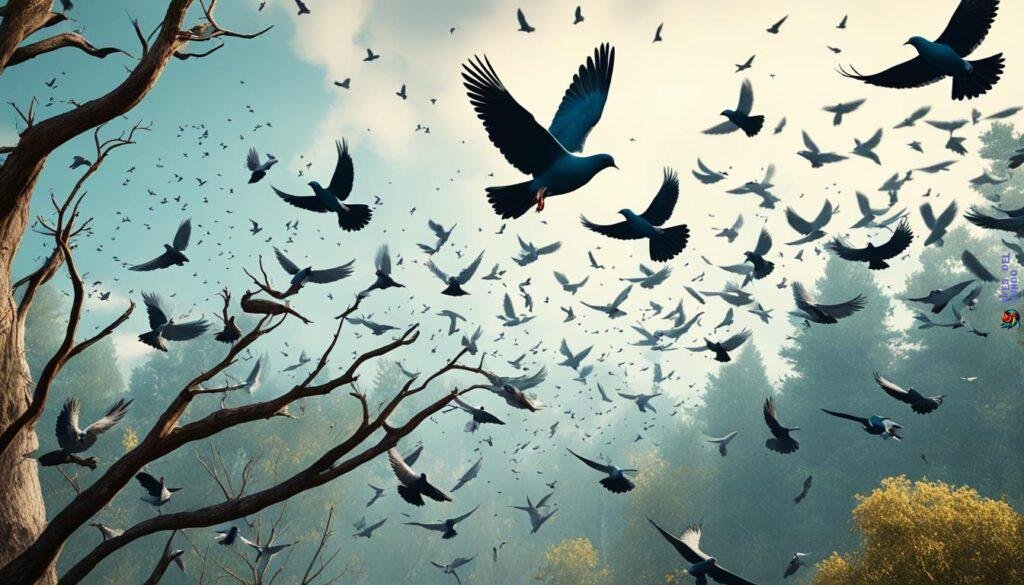
Some people worry about pigeons harming other birds. But it’s important to see the full picture of what pigeons do. They play a key role in spreading seeds and cycling nutrients in the places they live.
By realizing how pigeons help the city’s nature, you might start to see them differently. They are not just city problems but are also helping keep the city’s nature thriving. Seeing pigeons as helpers could change how we manage city wildlife.
Pigeons as Vectors of Zoonotic Diseases
Pigeons are common in cities, but they can pose health risks. They carry diseases, which can affect people. We need effective ways to manage these risks to keep everyone safe.
Impact of Pigeons on Public Health
Pigeons can spread diseases like Psittacosis and Histoplasmosis without showing symptoms. This makes them a public health concern. Cities strive to reduce these risks while caring for wildlife.
Strategies for Disease Control and Prevention
To protect public health, cities must have good plans to manage pigeon diseases. These efforts help stop infections, keeping everyone healthy and animals safe.
| Prevention Strategy | Action | Expected Outcome |
|---|---|---|
| Public Education | Share tips on safe pigeon interactions and staying clean. | People will know more and avoid pigeons. |
| Environmental Sanitation | Clean places with pigeon waste and install bird-proofing. | Less mess and fewer pigeon homes. |
| Wildlife Management | Lower pigeon numbers humanely and stop people feeding them. | A balanced ecosystem and fewer diseases. |
Your help in fighting pigeon-related diseases matters a lot. By being responsible and supporting community efforts, we can live better with our feathered friends.
Conservation Challenges: Pigeons vs. Native Bird Species
Urban areas are now where native and invasive birds fight for life. Knowing this helps in drawing up good plans to save our birds.
The Debate Over Invasive vs. Native Avifauna Balance
Pigeons have made cities their home, which often hurts the local birds. This issue is key for those wanting to save our native birds. It’s all about keeping a balance between protecting our native birds and controlling pigeons.
Conservation Efforts and Urban Wildlife Management
Because of this, actions to save local birds are getting stronger. These efforts include protecting their homes and teaching everyone why different kinds of birds matter. Managing city wildlife now means finding ways to deal with pigeons without hurting all birds.
| Conservation Concern | Impact on Native Birds | Management Strategies |
|---|---|---|
| Competition for Resources | Reduction in food supply and nesting sites for native birds | Implement feeding restrictions; enhance native habitat |
| Habitat Disruption | Alteration of local ecosystems, potentially reducing biodiversity | Restore and maintain natural areas within urban settings |
| Disease Transmission | Potential spread of avian diseases to native species | Monitor pigeon health; educate the public on good hygiene practices |
| Human Interaction | Increased dependency on human-provided food sources | Promote responsible wildlife feeding habits |
By supporting local bird conservation and smart city wildlife management, you make a difference. Your involvement helps keep our bird populations diverse and balanced for the future.
Reflections on Urban Stewardship and Bird Population Management
As cities grow bigger, taking care of our urban areas becomes very important. Pigeons play a big role in this, even though we often overlook them. Cities have a chance to improve how they manage bird populations. We should think about how pigeons and other birds work together. This is key to making our city environments rich and diverse.
An inclusive mindset towards taking care of our cities helps us think of ways to protect all kinds of birds. It’s about seeing the value pigeons bring and keeping the homes of local birds safe too. Doing this makes sure every species can coexist in harmony.
Your role is to stay aware and supportive of the issues and chances in managing birds in cities. Understanding the complexity of city ecosystems helps us see beyond the problems pigeons might cause. Ecologists, city planners, and you play a part in keeping our urban areas rich in wildlife. Your actions, like joining local conservation efforts, can make a big difference.
Thinking about managing bird populations shows us how connected we are to nature. Urban stewardship is more than taking care of our cities. It’s about living together with nature in a thoughtful way. When you back smart policies and city designs, you help ensure pigeons and local birds do well together. This balance is key not only for birds but for the health and future of our cities too.
